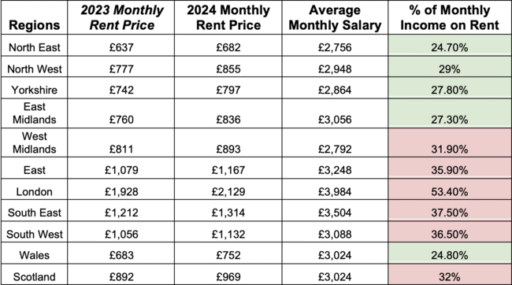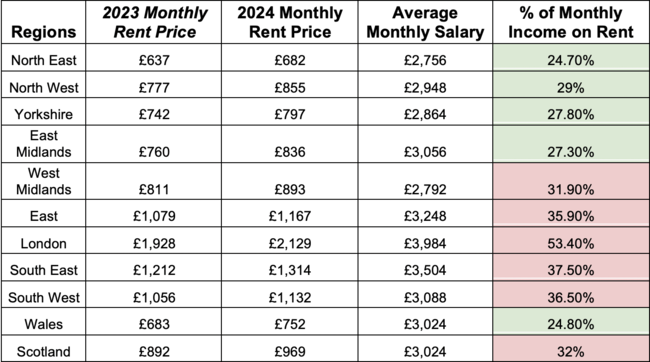Recent research from 2024, analysed by LandlordBuyers.com, reveals that private rental prices have risen across England (8.5%), Wales (8.5%), Scotland (7.6%) and Northern Ireland (9.9%) over the past year.
Experts recommend that individuals allocate no more than 30% of their monthly salary to rent. However, in several regions, tenants are required to spend well over this percentage:
- London = 53.4% of salary on rent
- South East = 37.5% of salary on rent
- South West = 36.5% of salary on rent
- East England = 35.9% of salary on rent
- Scotland = 32% of salary on rent
- West Midlands = 31.9% of salary on rent
This stands in contrast to areas in the UK where tenants are expected to spend less than 30% of their income on rent:
- North East = 24.7% of salary on rent
- Wales = 24.8% of salary on rent
- East Midlands = 27.3% of salary on rent
- Yorkshire = 27.8% of salary on rent
- North West = 29% of salary on rent
Commenting on the current rental market in the UK, Managing Director of LandlordBuyers.com, Jason Harris-Cohen, said: “A North-South divide definitely still exists but the divide is tapering. Only in mid-September did estate agent Hamptons release data that showed the gap between rental values in the North and rental values in the South of England has narrowed to its lowest point in over a decade”, he explains. “In fact, while it was still more expensive to rent in the South, Southern rents were only 37% more expensive than those in the North – down from 43% more in August 2023 and a peak of 55% more in November 2021.”
Jason notes that the future trajectory of this gap will depend on several factors. “One will be landlords themselves: which ones decide to exit the market and where their rentals are geographically located. Buy-to-let professionals are holding their breath ahead of autumn’s Budget. If pockets of landlords, perhaps mainly in the South, decide to sell, we could see supply restricted, values rise and the gap widen again.”
He adds, “Conversely, if Labour gets to grips with levelling up, we may see the appeal of Northern towns surge, wages catch up with Southern counterparts and demand for property – both to buy and rent – increase.”
Jason also highlights the influence of house prices. “House prices will play their part too. Stagnating property and rental values in the South have been blamed for the rental value slowdown, whereas house price growth in the North has been broadly strong. If this trend continues, we could see Northern values increase further and approach something more like rental equilibrium across the country.”
“When it comes to the gap between average salaries and average rental prices, the figures show there’s still an imbalance. While the Office for National Statistics revealed wage growth was running at 5.1% over the three months to the end of July 2024 – outpacing inflation at 2.2% – Goodlord found the average cost of a new rental home in England was 7% higher in August 2024, compared to the same point in 2023.”







